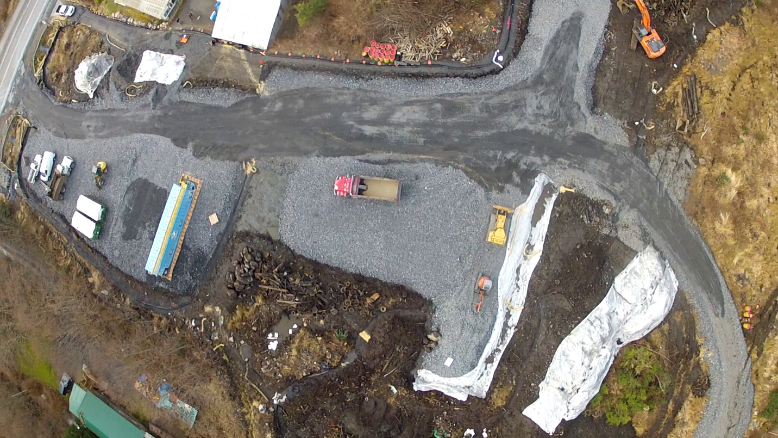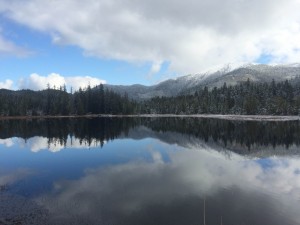
Old cars and other trash were removed from the old Byford Junkyard, leaving lead-contaminated soil, as shown in this 2016 aerial photo. The soil, which has been treated to bond the lead, will be trucked to a quarry near Pat’s Creek. (Photo courtesy Department of Environmental Conservation.)
Some Wrangell residents are opposing a state plan to store contaminated soil near a popular recreation area. But officials say it’s safe and they’re coming to the Southeast Alaska city to explain why.
The soil is from the old Byford Junkyard, about 4 miles from downtown. Old cars and other trash were removed a few years ago. What’s left is close to 19,000 cubic yards of soil heavily contaminated with lead.
The work is being overseen by the state Department of Environmental Conservation.
Staffer Sally Schlichting said the soil has been treated so it’s not dangerous.
“This material has been stabilized permanently, so it’s non-leachable. If rain falls on it, it won’t migrate out. It will just stay where it is. It’s not going to get into the water,” she said.
But some residents aren’t convinced.
Tis Peterman shared documents describing the work via the Wrangell Community Board Facebook page. It began an extensive, sometimes-emotional conversation.
“I’ve talked to quite a few people in the community and a lot of them were surprised this was happening. And it was supposed to start yesterday,” she said Tuesday.

Pat’s Lake, a popular Wrangell recreation area, is near a quarry that will store contaminated soil from the old Byford Junkyard. (Photo by Katarina Sostaric/KSTK)
She said much of the concern is because the storage site is a state-owned rock quarry near Pat’s Creek and Pat’s Lake, about 10 miles south of town.
That area is well used by community members.
“Everything from paddle boarding to fishing in the creek to harvesting blueberries, any kind of berries. And in the winter time there’s ice skating by community members. And there’s picnicking going on there. And the pit is located within a mile, I’d say, from that area,” she said.
Planning documents describe how the storage site will be covered to keep water from getting in. But it will not be lined.
Schlichting said a hydrology study shows the quarry is not connected to the creek, which flows into the lake.
Another community concern is contaminated soil blowing or falling out of trucks hauling it 8 miles from the abandoned junkyard to the quarry.
Schlichting said that’s being addressed.
“All of the dump trucks are going to be lined and covered. And there will be a traffic-control plan to prevent migration of contaminants along the whole route and to prevent releases to the marine environment and the aquatic environment and so on,” she said.
The contractor, Anchorage-based environmental cleanup company NRC Alaska, estimates about 20,000 dump truck loads will be delivered to the storage site.
Schlichting is in Wrangell this week to meet with local officials about the plan.
One stop is the Forest Service. District Ranger Bob Dalrymple has protested that the project was planned without his agency’s involvement.
He couldn’t be immediately reached for comment. But in a June 30 letter, he said the contaminated soil will be moved along a Forest Service road and could impact federal resources.
The state’s contractor finally wrote Dalrymple July 27 with official notification of the project.
Schlichting said the state hopes to start moving dirt soon.
“We would like to get started later in August, built it does depend on when the U.S. Forest Service can issue us a road-use permit,” she said.
She said work would break for winter and resume in the spring. Plans call for it to continue through June.
The state originally planned to ship the soil south, but storing it in Wrangell costs about half as much.
Editor’s note: Pat’s Creek and Lake are also known as Pats or Pat Creek and Lake.











